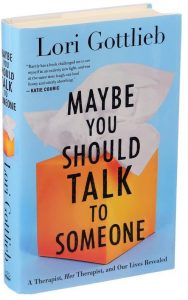The BEST: Maybe You Should Talk to Someone

The BEST: Maybe You Should Talk to Someone by Lori Gottlieb
Reviewed by Noah Marlowe
As the stigmas and taboos of mental health recede and retreat in the public eye, therapy – and talking about therapy – has become mainstream. Complementing the normalization of mental health discourse, therapists have shifted away from diagnosing mental illness and have embraced a more person-centered approach to therapy. Therapists are helping people navigate relationships; retell and celebrate their own personal narratives; understand and manage their emotions; imagine, craft, and attain occupational goals and aspirations; engage in meaning-making; and explore the contours and layers of their personality. Therapy as a methodology might then be listed among the best that has been thought and spoken.
 Summary: One of the most popular recent books in the therapy genre is Lori Gottlieb’s Maybe You Should Talk to Someone (Houghton Mifflin, 2019). Gottlieb, a journalist turned psychotherapist, tells the story of her encounter with an existential crisis in the midst of helping and supporting an eclectic group of four different patients. Along with her patients, Gottlieb (patient number five) also enters therapy to help her process the sudden and unexpected breakup with her long-time boyfriend. Gottlieb, in cunning secrecy and sagacious deception, seeks out her own therapist hoping for a short therapeutic stint that will validate her frustration in being suddenly dumped and help her deal with the immediate emotional baggage of a breakup. Spoiler: Gottlieb uncovers that the “unexpected” nature of her boyfriend dumping her was rooted in ignored and invisible signs, something that many patients discover in therapy. Throughout the book, Gottlieb describes her journey through therapy and personal discovery side-by-side with her providing therapy to patients in private practice. In a hilarious yet deeply profound way, Gottlieb showcases vulnerability, insecurity, fear, joy, love, and loss – illuminating the depth of human experience. Introductions to psychological and therapeutic concepts are dispersed throughout the book, bridging the worlds of storytelling and ideas.
Summary: One of the most popular recent books in the therapy genre is Lori Gottlieb’s Maybe You Should Talk to Someone (Houghton Mifflin, 2019). Gottlieb, a journalist turned psychotherapist, tells the story of her encounter with an existential crisis in the midst of helping and supporting an eclectic group of four different patients. Along with her patients, Gottlieb (patient number five) also enters therapy to help her process the sudden and unexpected breakup with her long-time boyfriend. Gottlieb, in cunning secrecy and sagacious deception, seeks out her own therapist hoping for a short therapeutic stint that will validate her frustration in being suddenly dumped and help her deal with the immediate emotional baggage of a breakup. Spoiler: Gottlieb uncovers that the “unexpected” nature of her boyfriend dumping her was rooted in ignored and invisible signs, something that many patients discover in therapy. Throughout the book, Gottlieb describes her journey through therapy and personal discovery side-by-side with her providing therapy to patients in private practice. In a hilarious yet deeply profound way, Gottlieb showcases vulnerability, insecurity, fear, joy, love, and loss – illuminating the depth of human experience. Introductions to psychological and therapeutic concepts are dispersed throughout the book, bridging the worlds of storytelling and ideas.
Why this is The BEST:
1. Within the world of modern publishing, especially in the social sciences, writers straddle the line of scholarship and readability/accessibility. Intellectuals, like Nobel prize-winners Daniel Kahneman and Richard Thaler, as well as university professors Jonathan Haidt , Jordan Peterson, and Steven Pinker, attempt to distill the conceptual richness and thoroughness of their scholarship to a broader lay audience. In so doing they render the unadulterated intellectual symposium accessible. Their goal, simply, is to bring “the best” of the academy to the general populace. On the other end of the spectrum, non-scholars and journalists like Malcom Gladwell and Michael Lewis popularize social science research, but sacrifice much of the rigor, scholarship, and conceptual depth of academic writers. These books are known for their colorful anecdotes and carefully-crafted narratives. Emerging between these two groups is a new genre: one that combines the narrative style of literature, the conceptual richness of social sciences, and the exploration of human experience at the center of the humanities. Such is Gottlieb’s book. Gottlieb writes with the pen of a journalist, the empathy of a psychotherapist, the raging pain of a broken-hearted lover, and with the ideas of a seasoned psychologist. Gottlieb, at once, teaches the reader about psychological constructs, touches their soul, makes them appreciate their humanity in a deeper way, and validates their experiences as people.
2. Human beings crave connection, love, and meaning. While opening ourselves up to others and welcoming vulnerability is challenging, Gottlieb’s book opens the inner worlds of others – and her own – to the reader. This is true of the book and the therapy process more broadly. This book shows that therapists, who are often looked at as people with all the answers, are just as human as the rest of us; they break into uncontrollable tears, make bad decisions, and hide their problems. (One might say that the same is true of rabbis, educators, etc., as well.) In Gottlieb’s words:
Therapists, of course, deal with the daily challenges of living just like everyone else. This familiarity, in fact, is at the root of the connection we forge with strangers who trust us with their most delicate stories and secrets. Our training has taught us theories and tools and techniques, but whirring beneath our hard-earned expertise is the fact that we know just how hard it is to be a person. Which is to say, we still come to work each day as ourselves – with our own set of vulnerabilities, our own longings and insecurities, and our own histories. Of all my credentials as a therapist, my most significant is that I’m a card-carrying member of the human race (7).
In addition to the idea that to be a therapist is to be deeply human (in stark contrast to the classical image of the stoic, emotionally-distant Freudian analyst), Gottlieb argues that the nature of therapy itself is the interface between the patient’s reflection and self-discovery and that of the therapist.
A therapist will hold up a mirror to patients, but patients will also hold up a mirror to their therapists. Therapy is far from one-sided; it happens in a parallel process. Every day, our patients are opening up questions that we have to think about for ourselves. If they can see themselves more clearly through our reflections, we can see ourselves more clearly through theirs. This happens to therapists when we’re providing therapy, and it happens to our therapists too. We are mirrors reflecting mirrors reflecting mirrors, showing one another what we can’t yet see (9).
Gottlieb also demonstrates the power of growth (and even post-traumatic growth), in therapy and out. Sometimes we just need a little a push, friendly encouragement, and honest reflection to improve our lives. This book powerfully displays the mechanics of therapy and gives those who have considered embarking on the journey of therapy a taste of the therapy experience. Gottlieb’s book is not a self-help book, but it teaches valuable lessons gleaned from the world of psychotherapy and hopefully gives readers permission to explore meeting with a therapist.
Caution: Throughout the book Gottlieb uses profanities and some explicit sexual language in order to more effectively give the reader the totality of her thoughts and feelings, mimicking the authenticity, rawness, and intimacy of the therapy experience.
Noah Marlowe, a magna cum laude graduate of Yeshiva College, is pursuing an MS, MSW, and semikha at Yeshiva University. He is currently a fellow at Jerusalem’s Gruss Kollel.
Click here to read about “The BEST” and to see the index of all columns in this series.
[Published on October 29, 2020]
